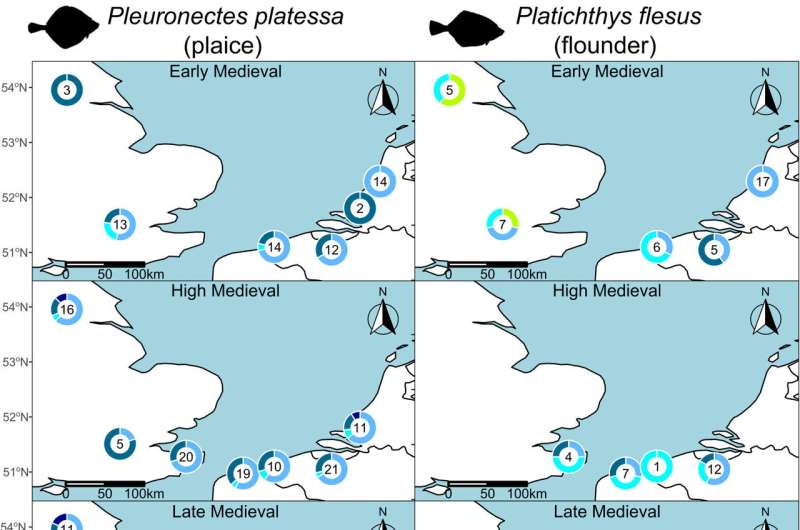This article has been reviewed according to Science X's editorial process and policies. Editors have highlighted the following attributes while ensuring the content's credibility:
fact-checked
peer-reviewed publication
trusted source
proofread
Plaice may have been most popular flatfish on dinner tables in medieval times

Flatfish, such as plaice, turbot and sole, were regularly consumed as part of a medieval meal, according to analysis of fishbone remains found at archaeological sites across Europe.
Previous research had shown that people ate flatfish during the medieval period, but until now it was unclear which types of flatfish they would have consumed and what this might tell us about fishing habits at that time.
Researchers from the University of York in collaboration with experts from France, Belgium and the Netherlands, identified plaice as the most popular flatfish, with flounder following close behind, and turbot, brill and Dover sole.
Not only were they able to identify the types of fish, but they found a pattern in how they were consumed, which suggested that the type of fish that was eaten at meal times was linked to the context in which they were consumed. Dover sole, for example, was only found in religious contexts, such as at monastery sites.
The work is published in the journal Fish and Fisheries.
Bone fragments
The researchers also discovered an increase in the frequency of plaice throughout the medieval period compared to the other species. This species became more popular towards the end of the medieval period, while flounder became less popular than before.
Katrien Dierickx, who completed the study as part of her Ph.D. at the University of York's Department of Archaeology, said, "We were able to look at the tiny bone fragments of more than 350 specimens found at medieval sites in the U.K., France, Belgium and the Netherlands.
"Using recent breakthroughs in molecular techniques, we could identify the species of fish, as well as uncover clues as to where they were caught.
"Most flatfish were caught in marine environments, while occasionally flounder was caught from rivers and estuaries, but this became less frequent post the 10th century. Plaice was caught in marine environments but more frequently further out to sea during the late medieval period.
"We see these shifts in popularity and fishing practices for a number of reasons. One is the growth of cities, which meant that people needed a steady food supply and the other is the impact of Christianity leading to the consumption of fish more frequently during Lent and on Fridays for example."
Trade networks
Research also suggests that trade networks and the influence of other cultures, such as those from Scandinavia, made fish a more popular dish and an easier product to obtain. The quality of freshwater environments is also thought to have decreased, causing fish from lakes and rivers to be eaten less, resulting in a larger demand and supply of marine fish, such as cod and haddock and, of course, flatfish.
Professor Michelle Alexander, academic supervisor on the study from the University of York's Department of Archaeology, said, "Scientific techniques have revealed the importance of flatfish to the medieval menu. In the later medieval period, fish was more widely available to most people and not just found on the tables of monks and high-status people.
"Fish is still important in today's diet, and many of us still observe 'fishy Friday' in the U.K."
The research was part of the SeaChanges network, a consortium of more than 25 institutions led by York.
The network's coordinator, Dr. David Orton, from the University's Department of Archaeology, said, "Archaeological remains can tell us a lot about the scale of human exploitation of the seas in periods before systematic fishing records—and about the potential for long-term human impact on fish stocks."
More information: Katrien Dierickx et al, Finding the right plaice at the right time: Multi‐molecular analysis of flatfish reveals historical catch habitats, Fish and Fisheries (2024). DOI: 10.1111/faf.12847
Journal information: Fish and Fisheries
Provided by University of York





















